WHAT IS LANGUAGE - Erciyes University
advertisement
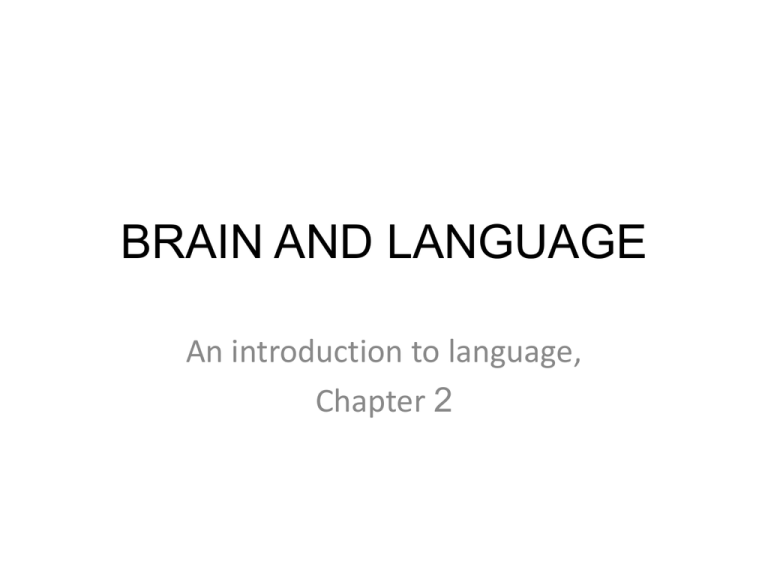
BRAIN AND LANGUAGE An introduction to language, Chapter 2 The human brain • The surface of the brain is the cortex, often called “gray matter,” consisting of billions neurons. • It receives messages from all of the sensory organs, initiates all voluntary and involuntary actions, and is the storehouse of our memories. Somewhere in this gray matter resides the grammar that represents our knowledge of language. The human brain • An issue of central concern has been to determine which parts of the brain are responsible for human linguistic abilities. Aphasia • the neurological term for any language disorder that results from brain damage caused by disease or trauma.. • The idea of localization: first proposed by Joseph Gall, is the idea that different cognitive abilities are localized in different part of brain. Aphasia • In the 1860s the French surgeon Paul Broca proposed that language is localized to the left hemisphere of the brain,and more specifically to the front part of the left hemisphere (now called Broca’s area). • He claimed that we speak with the left hemisphere. Broca’s finding was based on a study of his patients who suffered language deficits after brain injury to the left frontal lobe. Aphasia • A decade later Carl Wernicke, a German neurologist, described another variety of aphasia that occurred in patients with lesions in areas of the left hemisphere temporal lobe, now known as Wernicke’s area. • Language is lateralized to the left hemisphere, and the left hemisphere appears to be the language hemisphere from infancy on. Aphasia The linguistic characterization of aphasic syndormes • Broca’s aphasia • a disorder that affects a person’s ability to form sentences with the rules of syntax. • the language produced is often agrammatic: it frequently lacks articles, prepositions, pronouns, auxiliary verbs, and other grammatical elements that we will call “function words”. http://www.youtube.com/watch?v=f2IiMEbMnPM http://www.youtube.com/watch?v=1aplTvEQ6ew&feature=fvwrel • • The linguistic characterization of aphasic syndormes • people with Wernicke’s aphasia produce fluent speech with good intonation, and they may largely adhere to the rules of syntax. However,their language is often semantically incoherent. • one patient replied to a question about his health with: “I felt worse because I can no longer keep in mind from the mind of the minds to keep me from mind and up to the ear which can be to find among ourselves.” • People with damage to Wernicke’s area have difficulty naming objects presented to them and also in choosing words in spontaneous speech.They may make numerous lexical errors(word substitutions),often producing jargon and nonsense words, as in the following example: “The only thing that I can say again is madder or modder fish sudden fishing sewed into the accident to miss in the purdles.” • http://www.youtube.com/watch?v=UtadyCc_ybo&feature=related The linguistic characterization of aphasic syndormes • The linguistic deficits exhibited by people with Broca’s and Wernicke’s aphasia point to a modular organization of language in the brain. We find that damage to different parts of the brain results in different kinds of linguistic impairment (e.g., syntactic versus semantic). • The kind of word substitutions that aphasic patients produce also tell us about how words are organized in the mental lexicon. The linguistic characterization of aphasic syndormes • Sometimes the substituted words are similar to the intended words in their sounds. For example, pool might be substituted for tool, sable for table, or crucial for crucible. Sometimes they are similar in meaning (e.g., table for chair or boy for girl). • Neural connections exist among semantically related words and among words that sound alike. Words are not mentally represented in a simple list but rather in an organized network of connections. • The omission of function words in the speech of agrammatic aphasics shows that this class of words is mentally distinct from content words like nouns. Dyslexia • The term dyslexia refers to reading disorders. Dyslexia • The term dyslexia refers to reading disorders. • Many word substitutions are made by people who become dyslexic after brain damage. Dyslexia • The term dyslexia refers to reading disorders. • Many word substitutions are made by people who become dyslexic after brain damage. • One group of these patients, when reading words printed on cards aloud, produced the kinds of substitutions shown in the following examples. Dyslexia • The term dyslexia refers to reading disorders. • Many word substitutions are made by people who become dyslexic after brain damage. • One group of these patients, when reading words printed on cards aloud, produced the kinds of substitutions shown in the following examples. All these errors provide evidence that the mental dictionary has content words and function words in different compartments. Additional evidence for hemispheric structure of the brain • Additional evidence regarding hemispheric specialization is drawn from Japanese readers. Additional evidence for hemispheric structure of the brain • Additional evidence regarding hemispheric specialization is drawn from Japanese readers. • The Japanese language has two main writing systems. One system, kana, is based on the sound system of the language; each symbol corresponds to a syllable. The other system, kanji, is ideographic; each symbol corresponds to a word. Additional evidence for hemispheric structure of the brain • Additional evidence regarding hemispheric specialization is drawn from Japanese readers. • The Japanese language has two main writing systems. One system, kana, is based on the sound system of the language; each symbol corresponds to a syllable. The other system, kanji, is ideographic; each symbol corresponds to a word. • Japanese people with left-hemisphere damage are impaired in their ability to read kana, whereas people with right-hemisphere damage are impaired in their ability to read kanji. BRAIN IMAGING TECHNOLOGY BRAIN IMAGING TECHNOLOGY Split Brains • People suffering from intractable epilepsy may be treated by severing communication between their two hemispheres. Surgeons cut through the corpus callosum , the fibrous network that connects the two halves. • Such split-brain patients also provide evidence for language lateralization. Split Brains • People suffering from intractable epilepsy may be treated by severing communication between their two hemispheres. Surgeons cut through the corpus callosum , the fibrous network that connects the two halves. • Such split-brain patients also provide evidence for language lateralization. • The psychologist Michael Gazzaniga states: With [the corpus callosum] intact, the two halves of the body have no secrets from one another. With it sectioned, the two halves become two different conscious mental spheres, each with its own experience base and control system for behavioral operations. . . . Unbelievable as this may seem, this is the flavor of a long series of experimental studies first carried out in the cat and monkey. Split Brains • • What happens to people with split-brain operations If a pencil is placed in the left hand of a split-brain person whose eyes are closed, the person can use the pencil appropriately but cannot name it. The right brain senses the pencil but the information cannot be relayed to the left brain for linguistic naming. By contrast, if the pencil is placed in the right hand, the subject is immediately able to name it as well as to describe it because the sensory information from the right hand goes directly to the left hemisphere, where the language areas are located. The Autonomy of Language • there are children without brain lesions who nevertheless have difficulties in acquiring language or are much slower than the average child. Such children are suffering from specific language impairment. • Children with SLI have problems with the use of function words such as articles, prepositions, and auxiliary verbs. They also have difficulties with inflectional suffixes on nouns and verbs such as markers of tense and agreement. Several examples from a four-year-old boy with SLI illustrate this: • • • Meowmeow chase mice. Show me knife. It not long one. • SLI children show that language may be impaired while general intelligence stays intact, supporting the view of a grammatical faculty that is separate from other cognitive systems. The Autonomy of Language • Grammatical faculty is seperate from general intelligence. Laura – a retarded young woman with a nonverbal IQ of 41 to 44. – lacked almost all number concepts, including basic counting principles, and could draw only at a preschool level. – Nevertheless, Laura was able to produce complex sentences with multiple phrases and sentences with other sentences inside them. She used and understood passive sentences, and she was able to inflect verbs for number and person to agree with the subject of the sentence. She formed past tenses in accord with adverbs that referred to past time. She could do all this and more, but she could neither read nor write nor tell time Christopher Christopher has a nonverbal IQ between 60 and 70 . The tasks of buttoning a shirt, cutting his fingernails, or vacuuming the carpet are too difficult for him. However, his linguistic competence is as rich and as sophisticated as that of any native speaker When given written texts in some fifteen to twenty languages, he translates them quickly, with few errors, into English. CPH The Chomskyan idea that there is a critical age beyond which children can not acquire their native language with full competency. Evidence for CPH Victor; was found in the forest at 12 years old, had no contact with humans until then. ;was taught by a special doctor for five years after found. ; although the doctor was able to improve his judgement, sociability and memory, ; he could not teach him langauge. ; the only words he used were “milk” and “Oh God!” Genie; was found at 12 years old; kept in an isolated room alone by her father for 12 years ; did not have any contact with humans ;was trained and rehabilitated for 5 years be special doctors and teachers . ; her langauge ability after 5 years was much more deficient compared to a normal 5 year old. ; inconsistent grammar and overuse of formulaic utterances.
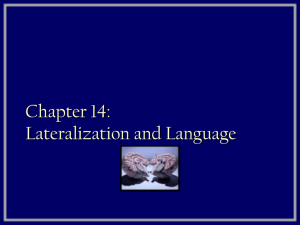

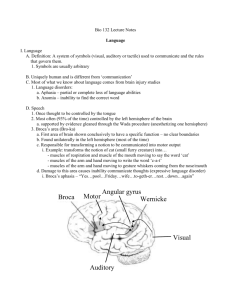
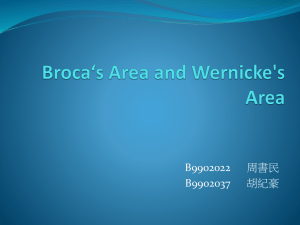
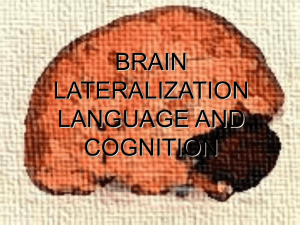
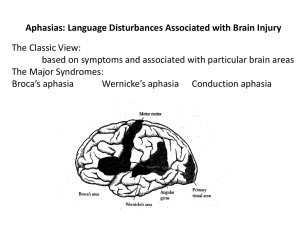
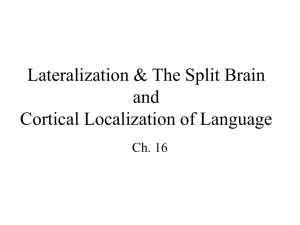

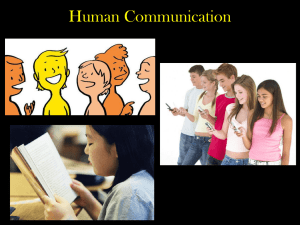

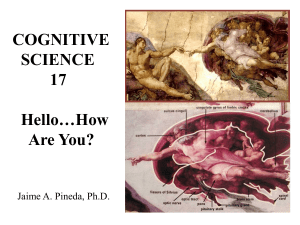
![Wernicke`s_area_presentation[1] (Cipryana Mack)](http://s2.studylib.net/store/data/005312943_1-7f44a63b1f3c5107424c89eb65857143-300x300.png)